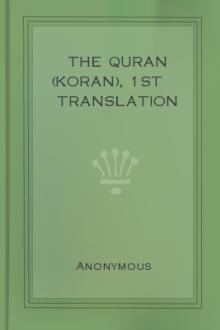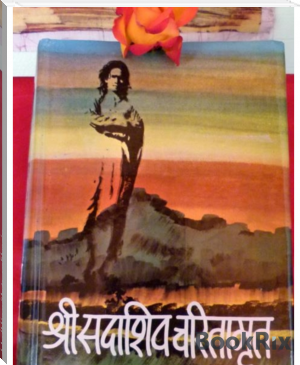The Quran (Koran), 1st translation by - (inspirational books to read txt) 📖

- Author: -
- Performer: -
Book online «The Quran (Koran), 1st translation by - (inspirational books to read txt) 📖». Author -
There is, however, apart from its religious value, a more general view from which the book should be considered. The Koran enjoys the distinction of having been the starting-point of a new literary and philosophical movement which has powerfully affected the finest and most cultivated minds among both Jews and Christians in the Middle Ages. This general progress of the Muhammedan world has somehow been arrested, but research has shown that what European scholars knew of Greek philosophy, of mathematics, astronomy, and like sciences, for several centuries before the Renaissance, was, roughly speaking, all derived from Latin treatises ultimately based on Arabic originals; and it was the Koran which, though indirectly, gave the first impetus to these studies among the Arabs and their allies. Linguistic investigations, poetry, and other branches of literature, also made their appearance soon after or simultaneously with the publication of the Koran; and the literary movement thus initiated has resulted in some of the finest products of genius and learning.
The style in which the Koran is written requires some special attention in this introduction. The literary form is for the most part different from anything else we know. In its finest passages we indeed seem to hear a voice akin to that of the ancient Hebrew prophets, but there is much in the book which Europeans usually regard as faulty. The tendency to repetition which is an inherent characteristic of the Semitic mind appears here in an exaggerated form, and there is in addition much in the Koran which strikes us as wild and fantastic. The most unfavourable criticism ever passed on Muhammed's style has in fact been penned by the prophet's greatest British admirer, Carlyle himself; and there are probably many now who find themselves in the same dilemma with that great writer.
The fault appears, however, to lie partly in our difficulty to appreciate the psychology of the Arab prophet. We must, in order to do him justice, give full consideration to his temperament and to the condition of things around him. We are here in touch with an untutored but fervent mind, trying to realise itself and to assimilate certain great truths which have been powerfully borne in upon him, in order to impart them in a convincing form to his fellow-tribesmen. He is surrounded by obstacles of every kind, yet he manfully struggles on with the message that is within him. Learning he has none, or next to none. His chief objects of knowledge are floating stories and traditions largely picked up from hearsay, and his over-wrought mind is his only teacher. The literary compositions to which he had ever listened were the half-cultured, yet often wildly powerful rhapsodies of early Arabian minstrels, akin to Ossian rather than to anything else within our knowledge. What wonder then that his Koran took a form which to our colder temperaments sounds strange, unbalanced, and fantastic?
Yet the Moslems themselves consider the book the finest that ever appeared among men. They find no incongruity in the style. To them the matter is all true and the manner all perfect. Their eastern temperament responds readily to the crude, strong, and wild appeal which its cadences make to them, and the jingling rhyme in which the sentences of a discourse generally end adds to the charm of the whole. The Koran, even if viewed from the point of view of style alone, was to them from the first nothing less than a miracle, as great a miracle as ever was wrought.
But to return to our own view of the case. Our difficulty in appreciating the style of the Koran even moderately is, of course, increased if, instead of the original, we have a translation before us. But one is happy to be able to say that Rodwell's rendering is one of the best that have as yet been produced. It seems to a great extent to carry with it the atmosphere in which Muhammed lived, and its sentences are imbued with the flavour of the East. The quasi-verse form, with its unfettered and irregular rhythmic flow of the lines, which has in suitable cases been adopted, helps to bring out much of the wild charm of the Arabic. Not the least among its recommendations is, perhaps, that it is scholarly without being pedantic that is to say, that it aims at correctness without sacrificing the right effect of the whole to over-insistence on small details.
Another important merit of Rodwell's edition is its chronological arrangement of the Suras or chapters. As he tells us himself in his preface, it is now in a number of cases impossible to ascertain the exact occasion on which a discourse, or part of a discourse, was delivered, so that the system could not be carried through with entire consistency. But the sequence adopted is in the main based on the best available historical and literary evidence; and in following the order of the chapters as here printed, the reader will be able to trace the development of the prophet's mind as he gradually advanced from the early flush of inspiration to the less spiritual and more equivocal rocle of warrior, politician, and founder of an empire.
G. Margoliouth.
1 Mahommed and the Rise of Islam, in Heroes of Nations series.
SELECT BIBLIOGRAPHYENGLISH TRANSLATIONS. From the original Arabic by G. Sale, 1734, 1764, 1795, 1801; many later editions, which include a memoir of the translator by R. A. Davenport, and notes from Savary's version of the Koran; an edition issued by E. M. Wherry, with additional notes and commentary (Trduubner's Oriental Series), 1882, etc.; Sale's translation has also been edited in the Chandos Classics, and among Lubbock's Hundred Books (No. 22). The Holy Qurdaan, translated by Dr. Mohammad Abdul Hakim Khan, with short notes, 1905; Translation by J. M. Rodwell, with notes and index (the Suras arranged in chronological order), 1861, 2nd ed., 1876; by E. H. Palmer (Sacred Books of the East, vols. vi., ix.).
SELECTIONS: Chiefly from Sale's edition, by E. W. Lane, 1843; revised and enlarged with introduction by S. Lane-Poole. (Trduubner's Oriental Series), 1879; The Speeches and Table-Talk of the Prophet Mohammad, etc., chosen and translated, with introduction and notes by S. Lane-Poole, 1882 (Golden Treasury Series); Selections with introduction and explanatory notes (from Sale and other writers), by J. Murdock (Sacred Books of the East), 2nd ed., 1902; The Religion of the Koran, selections with an introduction by A. N. Wollaston (The Wisdom of the East), 1904. See also: Sir W. Muir: The Koran, its Composition and Teaching, 1878; H. Hirschfeld: New Researches into the Composition and Exegesis of the Qoran, 1902; W. St C. Tisdale: Sources of the Qurân, 1905; H. U. W. Stanton: The Teaching of the Qurán, 1919; A. Mingana: Syriac Influence on the Style of the Kurân, 1927.
TO SIR WILLIAM MARTIN, K.T., D.C.L. LATE CHIEF JUSTICE OF NEW ZEALAND, THIS VOLUME IS DEDICATED, WITH SINCERE FEELINGS OF ESTEEM FOR HIS PRIVATE WORTH, PUBLIC SERVICES, AND EMINENT LITERARY ATTAINMENTS, BY THE TRANSLATOR. PREFACEIt is necessary that some brief explanation should be given with reference to the arrangement of the Suras, or chapters, adopted in this translation of the Koran. It should be premised that their order as it stands in all Arabic manuscripts, and in all hitherto printed editions, whether Arabic or European, is not chronological, neither is there any authentic tradition to shew that it rests upon the authority of Muhammad himself. The scattered fragments of the Koran were in the first instance collected by his immediate successor Abu Bekr, about a year after the Prophet's death, at the suggestion of Omar, who foresaw that, as the Muslim warriors, whose memories were the sole depositaries of large portions of the revelations, died off or were slain, as had been the case with many in the battle of Yemâma, A.H. 12, the loss of the greater part, or even of the whole, was imminent. Zaid Ibn Thâbit, a native of Medina, and one of the Ansars, or helpers, who had been Muhammad's amanuensis, was the person fixed upon to carry out the task, and we are told that he "gathered together" the fragments of the Koran from every quarter, "from date leaves and tablets of white stone, and from the breasts of men."1 The copy thus formed by Zaid probably remained in the possession of Abu Bekr during the remainder of his brief caliphate, who committed it to the custody of Haphsa, one of Muhammad's widows, and this text continued during the ten years of Omar's caliphate to be the standard. In the copies made from it, various readings naturally and necessarily sprung up; and these, under the caliphate of Othman, led to such serious disputes between the faithful, that it became necessary to interpose, and in accordance with the warning of Hodzeifa, "to stop the people, before they should differ regarding their scriptures, as did the Jews and Christians."2 In accordance with this advice, Othman determined to establish a text which should be the sole standard, and entrusted the redaction to the Zaid already mentioned, with whom he associated as colleagues, three, according to others, twelve3 of the Koreisch, in order to secure the purity of that Meccan idiom in which Muhammad had spoken, should any occasions arise in which the collators might have to decide upon various readings. Copies of the text formed were thus forwarded to several of the chief military stations in the new empire, and all previously existing copies were committed to the flames.
Zaid and his coadjutors, however, do not appear to have arranged the materials which came into their hands upon any system more definite than that of placing the longest and best known Suras first, immediately after the Fatthah, or opening chapter (the eighth in this edition); although even this rule, artless and unscientific as it is, has not been adhered to with strictness. Anything approaching to a chronological arrangement was entirely lost sight of. Late Medina Suras are often placed before early Meccan Suras; the short Suras at the end of the Koran are its earliest portions; while, as will be seen from the notes, verses of Meccan origin are to be found embedded in Medina Suras, and verses promulged at Medina scattered up and down in the Meccan Suras. It would seem as if Zaid had to a great extent put his materials together just as they came to hand, and often with entire disregard to continuity of subject and uniformity of style. The text, therefore, as hitherto arranged, necessarily assumes the form of a most unreadable and incongruous patchwork; "une assemblage," says M. Kasimirski in his Preface, "informe et incohérent de préceptes moraux, religieux, civils et politiques, męlés d'exhortations, de promesses, et de menaces"-and conveys no idea whatever of the development and growth of any plan in the mind of the founder of Islam, or of the circumstances by which he was surrounded and influenced. It is true that the manner in which Zaid contented himself with simply bringing together his materials and transcribing them, without any attempt to mould them into shape or sequence, and without any effort to supply connecting links between adjacent verses, to fill up obvious chasms, or to suppress details of a nature discreditable to the founder of Islam, proves his scrupulous honesty as a compiler, as well as his reverence for the sacred text, and to a certain extent guarantees the genuineness and authenticity of the entire volume. But it is deeply to be regretted that he did not combine some measure of historical criticism with that simplicity and honesty of purpose which forbade him, as it certainly did, in any way to tamper with the sacred text, to suppress contradictory, and exclude or soften down inaccurate, statements.
The arrangement of the Suras in this translation is based partly upon the traditions of the Muhammadans themselves, with reference especially to the ancient chronological list printed by Weil in his Mohammed der Prophet, as well as upon a careful consideration of the subject matter of each separate Sura and its probable connection with the sequence of events in the life of Muhammad. Great attention has been paid to this subject by Dr. Weil in the work just mentioned; by Mr. Muir in his Life of Mahomet, who also publishes a chronological list of Suras, 21 however of which he admits have "not yet been carefully fixed;" and especially by Nöldeke, in his Geschichte des Qôrans, a work to which public honours were awarded in 1859 by the Paris Academy of Inscriptions. From the arrangement of this author I see no reason to depart in regard to the later Suras. It is based upon a searching criticism and minute analysis





Comments (0)